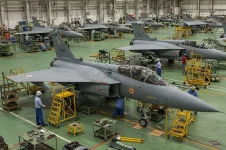- Views: 5K
- Replies: 7
The IAF is clearly facing a shortfall in overall squadron numbers as well as capabilities when it comes to fighter jets and is exploring all options to plug the gaps. The recent leaning towards trimming the MRFA, intended at procurement of 4.5 Gen jets like Rafale, to 60 aircrafts and procurement of 60 5th generation jets for capabilities, as per media reports, seems to be a thinking vector pointed towards the right direction as it will address both quantitative as well as qualitative issues.
However, the question it raises is about the 5th gen jet options India could consider. The obvious choices are the American F-35 Lightning II and the Russian Su-57 Felon. However, the question is can India also consider the KF-21 Boramae as well as another possible option on the table to meet both its quantitative as well as qualitative requirements, that is 4.5 and 5th gen requirement collectively by considering the KF-21 for the MRFA. Let’s discuss the merits & demerits of that option.
KF-21: The Backdrop
The KF-21 program was initiated by the Republic of South Korea in 2011 to replace its existing, in-service American F-4 Phantom II and F-5 Tiger II fighter jet platforms belonging to the 1960s era with an indigenous fighter platform featuring state-of-the- art technologies as well as capabilities. In future, the ROSK plans to replace even its current F-16s and the F-15Ks with the KF-21. The KF-21, however, originally started out as a planned true 5th generation stealth jet platform; however, the requirements were abruptly scaled down to a 4.5 gen plus platform mid-way for the interim by the Korean MoD, seemingly, owing to urgent operational requirements.F-35 as the Mould and the Two-Phase Build Plan – Current and the Future
Built on the F-35 as the role model to emulate, the KF-21 has 65% indigenous content and rest sourced from international partners, under respective technology licenses, with the U.S. as the true & overarching archangel. The overall design features & cues as well as the performance specs of the KF-21, thus, unsurprisingly, are modeled upon and closely match the F-35, including, size, MTOW range of around 55,000 (for KF-21) to 65,000 lbs (for F-35), operating range of around 1,500 NM and payload capacity of around 17,000 lbs-18,000 lbs. Further, in terms of avionics, it features a AESA radar, Infrared Search and Track (IRST) capability, an EW suite and an Electro-Optical Targeting Pod.However, the key differences between the duo are underscored, primarily, by the fact that the F-35 is a single engine jet with its P&W developed F135 engine producing 28,000 lbf of thrust in dry mode & 43,000 lbf in wet mode while the KF-21 is a twin-jet featuring GE’s F414-400K engines with each one producing 13,000 lbf/22,000 lbf of thrust output rating. The use of two engines significantly reduces the risk of a potential engine flameout situation considerably, especially for naval operations, despite the high reliability of modern turbofan engines. Secondly, the KF-21 has a better top speed of the two pegged at Mach 1.8, as compared to the F-35’s Mach 1.6, owing to the twin-engine configuration and a slightly better thrust-to-weight ratio of the duo.
However, the KF-21 currently lacks the advanced sensor fusion, network centric warfare, and stealth capabilities of the F-35, being developed as a 4.5 gen plus fighter but with a smaller radar cross section for reduced visibility than the current Rafale and the Eurofighter Typhoon. The planned Bock III upgrades to the KF-21, to create KF-21EX, however, are planned to incorporate advanced avionics, 5th generation stealth with radar absorbent material & coatings, manned-unmanned teaming capability and an internal weapons bay. South Korea is also mulling plans to develop a naval, carrier-based variant, termed the KF-21N featuring larger & folding wings and a reinforced landing gear.
The KF-21 Boramae, after its successful test flight in 2022, is scheduled to start with series production in 2026 with the first batch to be delivered to the Republic of Korea Air Force (ROKAF) in 2028. Further, Indonesia is a cost sharing development partner on the program and already has orders placed for the KF-21. On the international front, several nations have shown active interest in procuring the KF-21 for replacing their legacy platforms, including, Poland which already has procured the F/A-50 jet from South Korea, in addition, to Philippines, Saudi Arabia, UAE and Malaysia.
What’s in it for India?
Pros
1. The KF-21 could meet India’s pressing requirement of a 4.5 gen fighter jet, being currently sought under MRFA, to beef up IAF’s overall squadron numbers with a jet just entering full-scale production in 2026 with deliveries of initial batches possible within the next 2-3 years.2. Further, India could negotiate the provision of source code to integrate its domestically developed avionics and weapon systems, like the Uttam & Virupaksha AESA radars, EW suite and AAMs like the Astra Mk I-III, as desired.
3. A Make-in-India manufacturing arrangement could be signed with South Korea for domestic manufacturing of airframes within India for the long term later, which could even be fitted with the same GE F414 engines, which are to be locally produced by HAL for Tejas Mk II and the AMCA going forward.
4. The procured KF-21s could even be upgraded later to full 5th gen fighter configuration by India domestically, with technologies being developed for the AMCA, as and when they become available. Thus, buying the KF-21 as a 4.5 gen fighter, under trimmed MRFA need, could, in turn, eventually become India’s another 5th gen fighter platform which could complement the AMCA and the other 5th gen fighter platform (to be procured for the interim) in future, and thus, could quickly beef-up India’s in-service 5th gen fighter fleet.
5. The initial contract placed by the ROKAF in 2024 for the KF-21 pegged the cost of a KF-21 airframe at $70.5 million. However, the latest order, placed in June 2025, had an upward revision in price due to inflation and an increase in cost of production to $87 million per airframe and $110 million per unit after fitting in the two F414s. But the same is still being touted as being lower and more competitive than other international options, such as Rafale and the F-35.
6. Structural changes to the twin engine KF-21 could make it capable of even carrier-based operations with the development of a naval variant, which might even obviate the need for off-the-shelf procurement of Rafale Marine or the Rafale-M, with a Make in India alternative.
Cons
1. The presence of U.S. technologies onboard the KF-21 would mandatorily require export clearances from the U.S. before South Korea can sign any international export deals for the KF-21.2. Delays in engine deliveries from GE for the F414 would be the same hurdle being faced currently by India.
3. The KF-21 is still under development and is not combat proven, unlike Rafale, which the IAF is clearly likely to lean towards for fleet synergies reason.
4. Geopolitical alignment and overall foreign policy considerations have to be taken into account and duly factored in as India has so far procured fighter jets solely only from France and Russia/Soviet Union with the sole exception of SPECAT Jaguars.
5. The procurement & under license production of a foreign fighter platform might stifle the development of upcoming domestic programs, like AMCA and the TEDBF.
6. Addition of another fighter type to IAF’s already diversified fighter fleet would add further complexity, in terms, of the need for creation of a separate supply chain for spares and for the development of domestic maintenance, repair and overhaul capabilities from scratch.
Regards,
Rajat Narang
Researcher, Author, Historian




